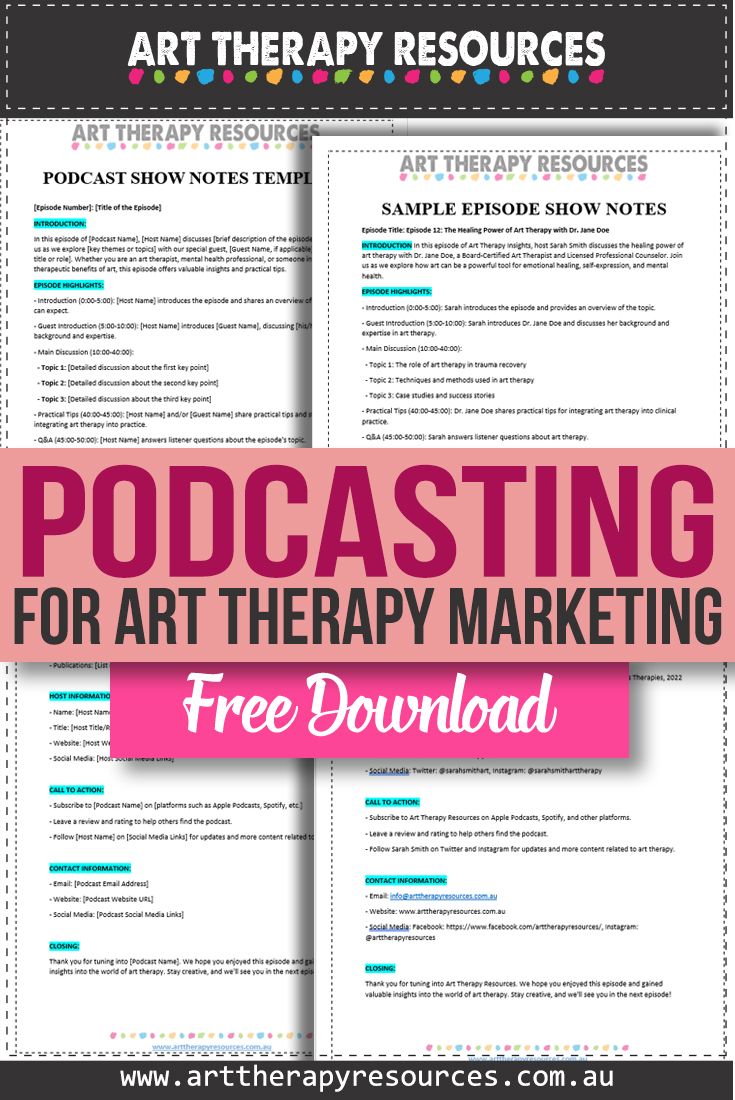THIS POST INCLUDES:
1. Podcasting for Marketing
2. Defining Podcasting Goals
3. Free Download Podcast Show Notes Template
PODCASTING FOR MARKETING

Art therapists are increasingly turning to podcasting as a powerful tool for reaching a broader audience. This medium allows therapists to extend their reach beyond their immediate geographic area, tapping into a global audience interested in the benefits of art therapy. By sharing insights, techniques, and personal experiences, art therapists can cultivate a following and create a community of listeners who are keen to learn more about this therapeutic approach.
Podcasting offers untapped potential for art therapy marketing. It provides a unique opportunity to engage with your target audience on a deeper level, fostering a sense of connection and community. Through regular podcast episodes, you can educate your audience about the benefits of art therapy, share success stories, and provide practical tips for incorporating art into their own therapeutic practices.
Additionally, podcasts can serve as a platform for collaboration with other professionals in the field. By featuring guest experts, you can introduce your audience to new perspectives and expand the scope of your content. Collaborative episodes can also help you reach new audiences and enhance your credibility.
CREATE A PODCAST
One of the most direct ways to leverage podcasting is by creating your own podcast. This approach gives you complete control over the content, format, and frequency of your episodes. Starting a podcast involves several key steps, beginning with the conceptualization of your podcast theme and objectives. What unique perspectives can you offer? What topics will you cover? Answering these questions will help shape the direction of your podcast.
Even if you have no audience at the outset, creating podcast episodes is an excellent way to build a content library. Podcasting, like blogging, is an evergreen format—episodes remain accessible to new listeners long after they are first published. This means that over time, as your podcast gains traction and attracts listeners, your early episodes will continue to provide value. Moreover, a well-curated collection of podcast episodes can serve as a valuable resource for clients, colleagues, and anyone interested in art therapy.
APPEAR ON A PODCAST
Another effective strategy is to market yourself as a guest on other established podcasts. This can be particularly beneficial if you are new to podcasting or if you want to tap into an existing audience. Many podcasters are constantly seeking knowledgeable and engaging guests who can provide value to their listeners. By reaching out to podcasts that align with your expertise in art therapy, you can share your insights and connect with a broader audience without the initial overhead of starting your own show.
Appearing as a guest on other podcasts also helps to build your credibility and visibility within the podcasting community. It allows you to showcase your expertise, share your unique therapeutic approaches, and discuss the benefits of art therapy in a conversational format. Additionally, it provides an opportunity to cross-promote your services and attract potential clients who resonate with your message.
EVERGREEN CONTENT
Like blogging, podcasting creates evergreen content that remains relevant and accessible over time. This aspect of podcasting is particularly advantageous because it allows art therapists to continuously engage with their audience, providing ongoing value through each episode. As your podcast library grows, new listeners can access your previous episodes, creating a continuous cycle of engagement and discovery.
Even if you start with a small audience, the potential for growth is significant. Each episode you release contributes to your body of work and increases the chances of attracting new listeners. By consistently producing high-quality content, you can gradually build a loyal following and establish yourself as a trusted voice in the field of art therapy.
SHOWCASE EXPERTISE
Art therapists can leverage podcasts to showcase their expertise, share therapeutic insights, and establish themselves as authorities in the field. This platform allows for in-depth discussions on various aspects of art therapy, from specific techniques and interventions to broader topics such as the benefits of creative expression in mental health.
By consistently delivering insightful and informative content, art therapists can position themselves as thought leaders in their field. This not only enhances their professional reputation but also builds trust with their audience. Listeners who find value in your podcast are more likely to seek out your services, recommend your podcast to others, and engage with you on other platforms.
From a professional perspective, engaging in discussions on art therapy can often help develop your own ideas on your art therapy practice. While it is a marketing benefit to work on establishing expertise in your field, it is also a beneficial to your professional development when your ideas are discussed with other art therapists with the view of expanding our understanding about art therapy.
PRACTICAL STEPS TO START
If you’re considering starting your own podcast or marketing yourself as a guest, here are a few practical tips to get you started:
1. Define Your Niche: Clearly define the focus of your podcast. Identify the key topics you want to cover and the unique value you can offer to your listeners.
2. Plan Your Content: Create a content calendar outlining the themes and topics for each episode. Planning ahead ensures that you have a steady stream of content and helps maintain consistency.
3. Invest in Quality Equipment: Good audio quality is crucial for a successful podcast. Invest in a quality microphone, headphones, and recording software to ensure your episodes sound professional.
4. Promote Your Podcast: Leverage social media, your website, and other online platforms to promote your podcast. Engage with your audience by responding to comments, asking for feedback, and encouraging listeners to share your episodes.
5. Network with Other Podcasters: Build relationships with other podcasters in your field. Guest appearances on established podcasts can help you reach a wider audience and gain valuable exposure.
By embracing podcasting as a tool for marketing and professional development, art therapists can significantly enhance their reach, influence, and impact. Whether you choose to start your own podcast or collaborate with existing podcasters, the potential for growth and connection is immense.
CONNECTING WITH POTENTIAL CLIENTS
One of the most significant opportunities that podcasting provides is the ability to connect directly with potential clients. Art therapists can create episodes that address common questions and concerns about art therapy, explain the therapeutic process, and discuss the benefits of creative expression for mental health. By providing this valuable information, therapists can attract listeners who may be considering art therapy but are unsure if it’s the right fit for them.
Podcasts can also serve as a platform for sharing client success stories (with appropriate consent and confidentiality measures). Hearing real-life examples of how art therapy has helped others can be incredibly powerful and persuasive for potential clients. These stories can illustrate the impact of art therapy and help listeners envision how it might benefit them personally.
EDUCATING THE PUBLIC AND RAISING AWARENESS
Beyond potential clients, podcasts offer art therapists the opportunity to educate the general public about the field of art therapy. Many people are unfamiliar with art therapy and its benefits, and a podcast can be an effective way to raise awareness and provide education on this topic.
Art therapists can use their podcasts to demystify the process of art therapy, explain different techniques and interventions, and discuss the theoretical foundations that underpin their work. This educational content can help to normalize art therapy as a legitimate and effective form of mental health treatment, thereby reducing stigma and encouraging more people to seek out these services.
BUILDING PROFESSIONAL NETWORKS
Podcasting is not just about reaching potential clients; it also provides a valuable opportunity to connect with other professionals in the field. By featuring guest experts on their podcasts, art therapists can facilitate discussions on a wide range of topics, from new research findings to innovative therapeutic techniques. These collaborations can enhance the quality of the content and provide listeners with diverse perspectives.
Additionally, appearing as a guest on other podcasts can help art therapists expand their professional network. It allows them to share their expertise with new audiences and connect with colleagues who share similar interests and goals. These connections can lead to further collaborations, referrals, and professional development opportunities.
Podcasting presents a wealth of opportunities for art therapists to engage with their target audience, educate the public, build professional networks, and establish themselves as credible authorities in their field. By creating compelling and informative content, art therapists can leverage the dynamic and accessible medium of podcasting to enhance their marketing efforts and expand their reach. Whether starting their own podcast or collaborating with existing podcasters, art therapists can harness the power of this innovative platform to promote their practice and make a positive impact on the lives of their listeners.
DEFINING PODCASTING GOALS

Before diving into the world of podcasting, it’s essential to define clear goals for your art therapy podcast. Whether your objectives are to educate, inspire, or attract clients to your private practice, having a well-defined purpose will guide your content creation and overall podcast strategy.
Effective planning is the cornerstone of a successful art therapy podcast. It ensures that your content is focused, engaging, and aligned with your overall marketing and therapeutic goals. Below are key considerations and steps for planning your art therapy podcast.
DEFINING YOUR GOALS
The first step in planning your art therapy podcast is to define your goals. Are you aiming to educate the public about the benefits of art therapy? Do you want to provide support and resources for existing clients? Perhaps your goal is to connect with other professionals in the field or to attract new clients to your private practice. Having clear objectives will help guide your content creation and overall podcast strategy.
Once your goals are defined, consider how each episode can contribute to achieving these objectives. For example, if your goal is to educate, your episodes might focus on explaining different art therapy techniques, discussing the benefits of art therapy for various mental health issues, or sharing insights from recent research. If your goal is to attract new clients, you might include success stories, case studies, or interviews with satisfied clients (with their permission).
IDENTIFY YOUR AUDIENCE
Understanding your target audience is essential for creating content that resonates. Consider the demographic and characteristics of your ideal listeners. Are they potential clients looking for therapy services? Are they other mental health professionals interested in learning more about art therapy? Are they educators or parents seeking resources for helping children through art?
Once you have a clear picture of your target audience, tailor your content to address their specific needs and interests. This might involve explaining complex concepts in layman’s terms for a general audience or diving into more technical details for fellow professionals. Knowing your audience will also inform your choice of topics, the tone of your podcast, and the style of your presentation.
CREATING INFORMATION EPISODES
The success of your podcast will largely depend on the quality of your episodes. Engaging and informative content will keep listeners coming back for more. Start by brainstorming a list of potential topics. Consider the questions and concerns that your clients often bring up, current trends and developments in art therapy, and areas where you have particular expertise.
Structure each episode to include an introduction, the main content, and a conclusion. The introduction should briefly outline what the episode will cover and why it’s relevant to your listeners. The main content should be well-organized and focused, providing valuable insights and information. The conclusion can summarize the key points and suggest further resources or actions for listeners.
Incorporating different formats can also keep your podcast interesting. You might include solo episodes where you discuss a particular topic in depth, interviews with other experts in the field, panel discussions, or Q&A sessions where you answer questions from your listeners. Mixing up the format will keep your content fresh and engaging.
CHOOSING EQUIPMENT AND SOFTWARE
Quality audio is crucial for a successful podcast. Poor sound quality can turn listeners away, no matter how good your content is. Invest in a good microphone, headphones, and recording software to ensure professional sound quality. There are many affordable and beginner-friendly options available that can help you get started without a significant investment.
When choosing a microphone, consider whether you’ll be recording in a quiet, controlled environment or a space with more background noise. USB microphones are a popular choice for their ease of use and good sound quality. For recording software, options like Audacity (free) or Adobe Audition (paid) offer a range of features for editing and producing your episodes.
DEVELOP A CONSISTENT SCHEDULE
Consistency is key in podcasting. Regularly releasing episodes helps build a loyal audience and improves your podcast’s visibility in search rankings. Decide on a recording and release schedule that you can realistically maintain. Many successful podcasts release new episodes weekly or bi-weekly, but the frequency will depend on your available time and resources.
Plan your content calendar in advance, outlining the topics and formats for each episode. This will help you stay organized and ensure a steady flow of content. Batch recording several episodes at once can also save time and reduce the pressure of producing content on a tight schedule.
STRUCTURE YOUR EPISODES
A well-structured episode is essential for maintaining listener engagement. Start with a brief introduction that outlines the episode’s topic and what listeners can expect to learn. This helps set the stage and capture their interest from the outset.
The main content should be divided into clear, logical sections. Use transitions to move smoothly from one point to the next, and avoid overwhelming your listeners with too much information at once. Incorporate stories, examples, and anecdotes to illustrate your points and make the content more relatable.
Conclude each episode with a summary of the key points discussed. Offer any final thoughts or insights, and suggest additional resources or actions listeners can take. This not only reinforces the main messages but also provides a sense of closure and continuity.
PROMOTING YOUR PODCAST
Effective promotion is essential for growing your audience. Utilize social media platforms, art therapy communities, and relevant online forums to share your episodes and engage with potential listeners. Create eye-catching graphics and compelling descriptions to attract attention.
Cross-promotion with other podcasts can also help expand your reach. Appear as a guest on other podcasts, or invite other podcasters to appear on yours. This can introduce your content to new audiences and create valuable networking opportunities.
MEASURING ANALYTICS
Regularly review your podcast analytics to understand listener behavior and preferences. Pay attention to metrics such as episode downloads, listener retention rates, and engagement levels. This data can provide valuable insights into what’s working and what isn’t, allowing you to refine your content strategy and improve your podcast over time.
Be open to feedback and willing to adapt. As you gain experience and learn more about your audience, you may find new ways to enhance your podcast and make it even more effective.
Podcasting offers a wealth of opportunities for art therapists to connect with their audience, educate the public, and establish themselves as authorities in their field. By planning carefully and focusing on creating high-quality, engaging content, art therapists can leverage this dynamic medium to promote their practice and make a positive impact on their listeners. Whether starting their own podcast or collaborating with others, art therapists can harness the power of podcasting to reach new heights in their marketing efforts.
FREE DOWNLOAD: Art Therapy Exercise
SIGN UP below to gain access to our RESOURCE LIBRARY and download the FREE Art Therapy Podcast Show Notes Template.

BUILD YOUR ART THERAPY REFERENCE MATERIALS:
Pin this image to your Pinterest board.

SHARE KNOWLEDGE & PASS IT ON:
If you’ve enjoyed this post, please share it on Facebook, Twitter, Pinterest. Thank you!
